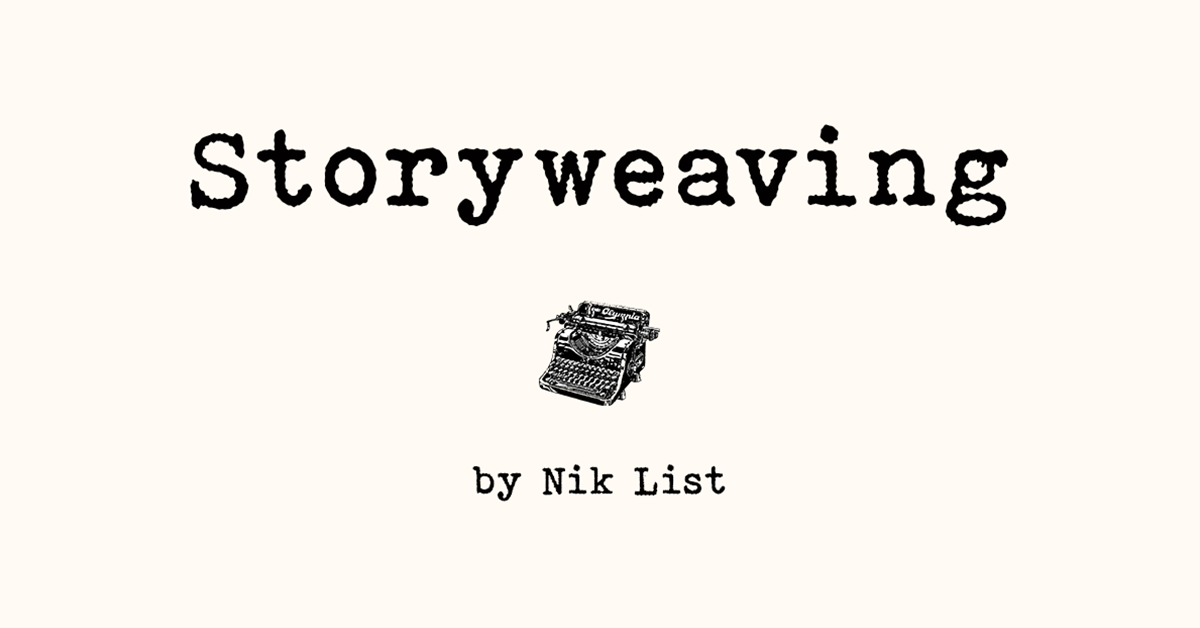STORYWEAVING
by Nik List
We tell ourselves stories in order to live.
~ Joan Didion
ABSTRACT – Drama is entertaining. Gossiping. Complaining. Grandstanding. The stories we use to regale our audiences – and ourselves – compel us to dramatize everything. But this compulsion comes with a heavy price. If we are to live our lives in fictions, best be mindful of the stories we spin: which stories to tell, and which stories to quell.
STEPPING OUT OF STORIES
WHAT’S YOUR STORY?
Career coaches often recommend polishing your story, your elevator pitch. Why is that?
Picture this:
A meets B for the first time at a party. A asks B – ‘So what do you do?’ B answers – ‘I work in a bank.’. In a blink of an eye, A draws up her image of bankers, and slaps it onto B. B now finds himself locked in A’s story of him — a story which might be very far from B’s reality. And B does the same to A. What started as a casual conversation has suddenly morphed into a full-blown 4-way interaction blending fiction and reality: A, A’s story of B, B, B’s story of A.
By storyweaving, we’re constantly overlaying facts with multiple layers of fictions and concepts. We do this all day, everyday, with everything: experiences, interactions, situations, people, and self.
STORYWEAVING
The mind compulsively weaves stories. For better or worse, our mental playwright continuously dramatizes every fact and fancies fictions willy nilly.
Due to our negativity bias, most of these stories make us miserable. Eckhart Tolle notes that a large part of unhappiness is not caused by situations, but instead by the narratives the mind layers on top of those situations.
These mental scenarios provide the lens through which we perceive the world. They condition our experiences and dictate, in large part, the quality of our lives. By stepping out of stories and consciously discriminating fact from fiction, we can begin to perceive the world afresh.
FRAMING STORIES
To understand how story framing works, think of photography. When we take a picture, we’re making 3 decisions:
- What do I leave in the frame?
- What do I leave out of the frame?
- Where do I stand to take the picture?
These 3 parameters enable us to frame any object in an infinite number of ways.
FRAMING REALITY
Reality requires framing. In its raw state, reality would be impossible to communicate. The simple question ‘How was the party last night?’ is impossible to answer accurately — conveying all the nuances, facial expressions, interactions, emotions, scents, sensations, impressions experienced over the course of an evening would be unfeasible. Instead, we frame it as a story: ‘It was ok.’ These 3 words have little, if not anything, to do with the actual experience of the party.
REFRAMING STORIES
Understanding how we frame stories enables us to reframe them, and potentially discover better stories to live with. As we’re caught up in our little melodramas, the mind’s wheels spin freewheeling, looping stories ad nauseam. ‘This is what she said – and that incompetent jackass did that – I can’t believe the nerve of this person – who the hell do they think they are…’. The mind loves milking these narratives.
To step out of that mental gridlock, try examining your story’s frame – Where are you starting the narrative? How much backstory are you including? Can you widen the lens? Maybe consider other points of view? The story of Gotham City can be told from Batman’s vantage point, but also from the Joker’s. Compassion, labels, and empathy all hinge on framing. Try it.
FROM STORIES TO STANDARDS
By weaving stories, the mind creates standards — models of how things should be. Weighing up a story of ‘how things should be’ against how things are is a recipe for misery. “This shouldn’t be happening.” “It’s a shame.” “It’s wrong.” According to which storyline shouldn’t it be happening? Which is more painful: the facts or their dramatization?
Dropping the stories makes it easier to dance with reality. The less expectations you have, the happier you’ll be. Take rain, for example. You can experience either ‘rain’ or ‘crummy weather that spoils everything’. In both cases, drops of water are falling from the sky. Which frame feels better?
ONE
We traditionally perceive our lives as individual storylines. As stories, these lives can ‘fall apart’, ‘make no sense’, or ‘end too soon’. We might be the only species that narrates life. Do trees experience themselves as individuals? Do bacteria undergo midlife crises? Do mice fret about ‘my future’? Does each blade of grass perceive itself as separate from the whole? The human mind segregates and narrates. But maybe one energy runs through everything. Separation might be an illusion.
Here’s an alternative. Being in the moment. Dancing with each situation as it presents itself. Not reminiscing about the past, nor anticipating a future. One breath at a time. Simple facts. Here. Now. No additional story.
“We tell ourselves stories in order to live,” writes Joan Didion. Didion didn’t say we needed stories for everything. We get to choose which ones to tell ourselves.

